Assessment of LCH Limited's SwapClear Service Appendix A: Activity in SwapClear
A.1 Global Activity
The notional value of trading activity cleared by SwapClear's 122 direct clearing participants contracted by around 14 per cent over the assessment period (Graph 1).[20] Much of the variation in activity through the year was driven by changing expectations regarding the likely future path of global monetary policy settings. In particular, the emergence of the COVID-19 pandemic, and the associated increase in market expectations for policy rate reductions, saw monthly activity in the SwapClear service peak at a record US$142 trillion in March, before reverting back towards historical levels of activity.

By product, much of the pick-up and subsequent pullback in activity occurred in OIS, owing to their link to short-term policy rates (Graph 2). Changes in activity in FRA and IRS were less pronounced but followed a similar pattern.
OIS, FRA and IRS accounted for 95 per cent of the notional value of trades registered. SwapClear also clears other products including basis swaps, zero-coupon swaps, variable notional swaps (VNS), NDIRS and inflation swaps. SwapClear clears OTC IRD in 27 currencies.

Around 44 per cent of trades registered were denominated in USD and 23 per cent in EUR (Graph 3). The AUD was SwapClear's fourth most registered currency and accounted for around 5 per cent of trade registrations.
The relatively short duration of OIS positions (typically less than 6 months) and the decline in new OIS trades registered during the second half of the assessment period led to a fall in the stock of derivatives outstanding (Graph 4).


Total initial margin requirements, which is a measure of the level of market risk a CCP manages, increased in early 2020 as the COVID-19 pandemic unfolded. This was in response to a combination of heightened market volatility and increased trading activity (Graph 5). However, the increase in initial margin requirements due to these factors was less severe than it otherwise would have been because of the anti-procyclical design of LCH Ltd's margin system. The margin system incorporates a floor, which requires participants to post additional margin when volatility falls to a low level. Prior to the increase in market volatility, around 80 per cent of house and client accounts were subject to this additional margin requirement (Appendix B).[21]
The proportion of initial margin requirements met by clients (as opposed to participants) increased over the assessment period, from 55 per cent in 2019 to over 60 per cent in June 2020 (Graph 6).[22] Much of this increase was driven by the continued growth in client clearing at SwapClear due to changing incentives for firms that are not subject to mandatory clearing requirements. These incentives include increased liquidity and netting benefits for centrally cleared derivatives, and changing regulations such as higher capital and margin requirements for OTC derivatives that are not centrally cleared.
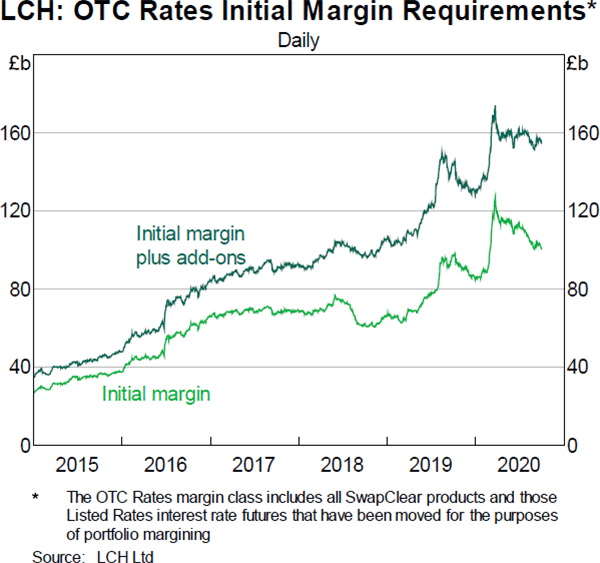
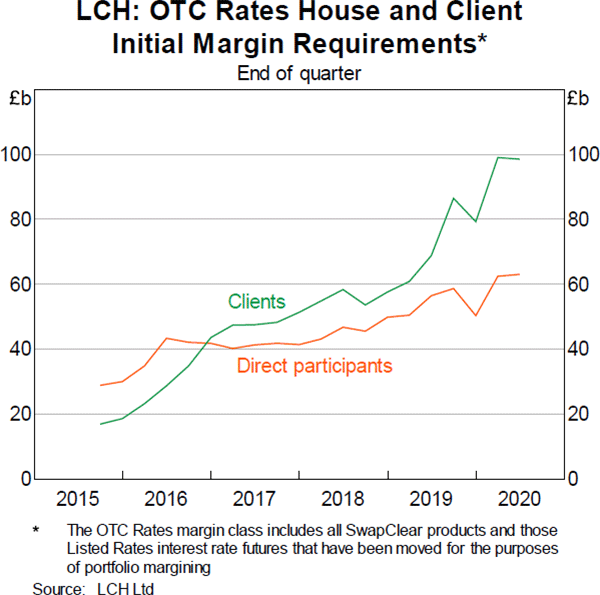
Variation margin flows, which prevent the build-up of current exposures as prices move, peaked in early 2020 alongside the increase in volatility and positions, but have since reverted to pre-COVID-19 levels as market conditions and trading activity stabilised (Graph 7 and Graph 8). Average daily variation margin flows in the March quarter were $22.7 billion, 28 per cent higher than in the September 2019 quarter. The number and value of intraday margin calls, which are made when a participants' margin liabilities exceed a predetermined credit threshold, followed a similar pattern (Graph 9).
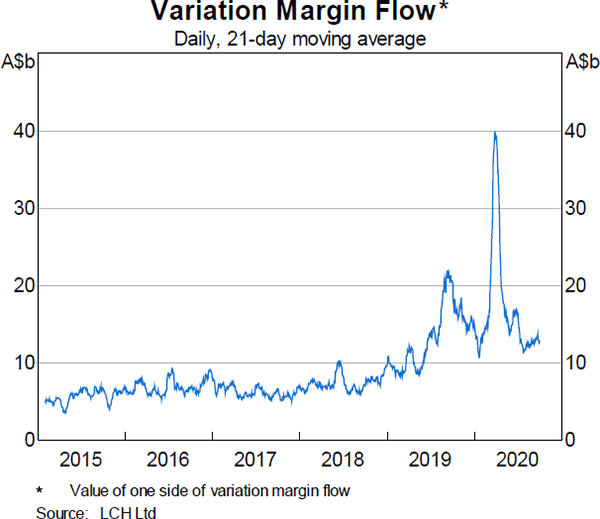
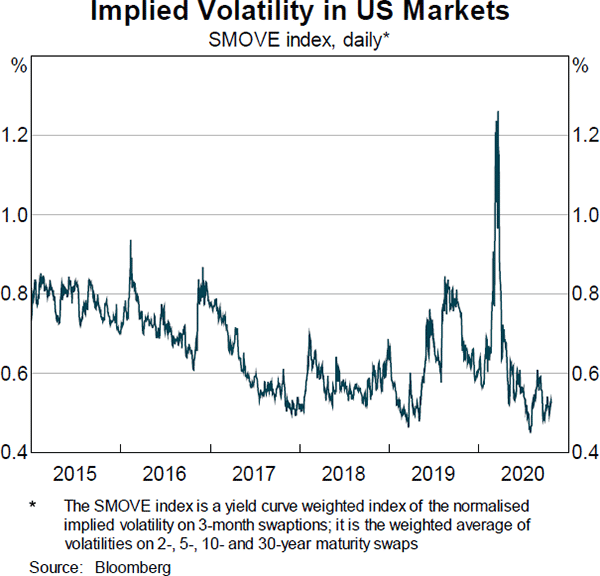


LCH Ltd accepts cash and non-cash collateral in a range of currencies, with collateral eligibility differing between types of margin calls and default fund contributions.[23] Total collateral held by the SwapClear service increased around 9 per cent over the assessment period (Graph 10). While LCH Ltd accepts Australian government securities and AUD cash as initial margin, AUD collateral accounts for less than 1 per cent of total collateral held; the majority of collateral held (86 per cent) is denominated in USD, GBP or EUR.
A.2 Australian Activity
A.2.1 Australian-domiciled direct clearing participants
SwapClear has six Australian-domiciled direct clearing participants – Australia and New Zealand Banking Group Ltd, Commonwealth Bank of Australia, Goldman Sachs Financial Markets Pty Ltd, Macquarie Bank Limited, National Australia Bank Limited, and Westpac Banking Corporation.
The total notional value of Australian participants' IRD outstanding (in all currencies) cleared via SwapClear declined by 8.5 per cent in AUD terms over the assessment period (Graph 11).
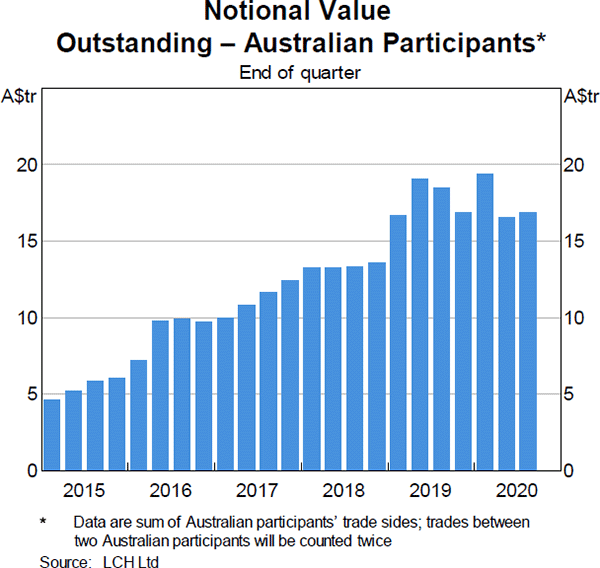
A.2.2 AUD-denominated OTC IRD
Globally, an estimated 85 per cent of all centrally cleared AUD-denominated OTC IRD registered during the assessment period were cleared via SwapClear. The notional value of AUD trading activity mirrored the global pattern, with changing expectations around the likely path of Australian monetary policy settings driving intra-year variation in OIS trading activity (Graph 12).

A.3 Operational Performance
The number of trades registered at SwapClear in the assessment period increased by around 6 per cent relative to the previous year (Graph 13). LCH Ltd deems its capacity utilisation target to be met if the service has the capacity to handle the greater of either (i) two times the daily peak throughput of trades registered over the previous two years, or (ii) the projected daily average throughput in 12 months' time. LCH Ltd met its target in each month in the assessment period for the SwapClear service, including when record trade volumes were experienced in March.
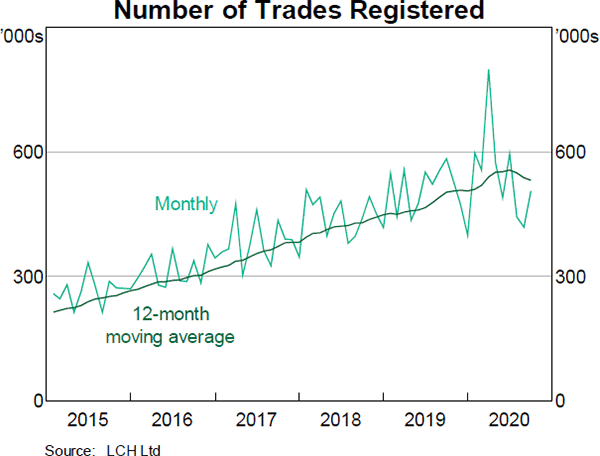
LCH Ltd targets IT system availability for the SwapClear service equivalent to at least 99.7 per cent. In effect this means that system outages should last no more than 2 hours in any one calendar month.[24] SwapClear met this target in 11 months of the assessment period; IT system availability averaged 99.9 per cent.
Footnotes
Unless otherwise stated, all positions data reported in this Appendix are as at the end of the assessment period (30 September 2020), while all activity data and growth rates are reported over the 12 months to the end of the assessment period. [20]
Initial margin add-ons are also called to cover risks not captured in the base initial margin model, including credit, liquidity, sovereign and concentration risks. [21]
For further information on client clearing, see Box A in the 2017/18 Assessment of LCH Limited's SwapClear Service. Available at <https://www.rba.gov.au/payments-and-infrastructure/financial-market-infrastructure/clearing-and-settlement-facilities/assessments/lch/2018/>. [22]
LCH Ltd accepts: GBP cash for default fund contributions, eligible cash and non-cash collateral for initial margin, and eligible cash for intraday margin calls. Variation margin must be met in the currency of the underlying exposure. For further information, see LCH Ltd's website on LTD Acceptable Collateral. Available at <https://www.lch.com/collateral-management/ltd-collateral-management/ltd-acceptable-collateral>. [23]
LCH Ltd weights outages to calculate service availability: a weight of one where there is full service outage; a weight of 0.5 or 0.25 for partial outages, depending on the incident; and a weight of zero for partial losses of resilience, such as when the service is still operating but an additional server used to share the load is unavailable. [24]